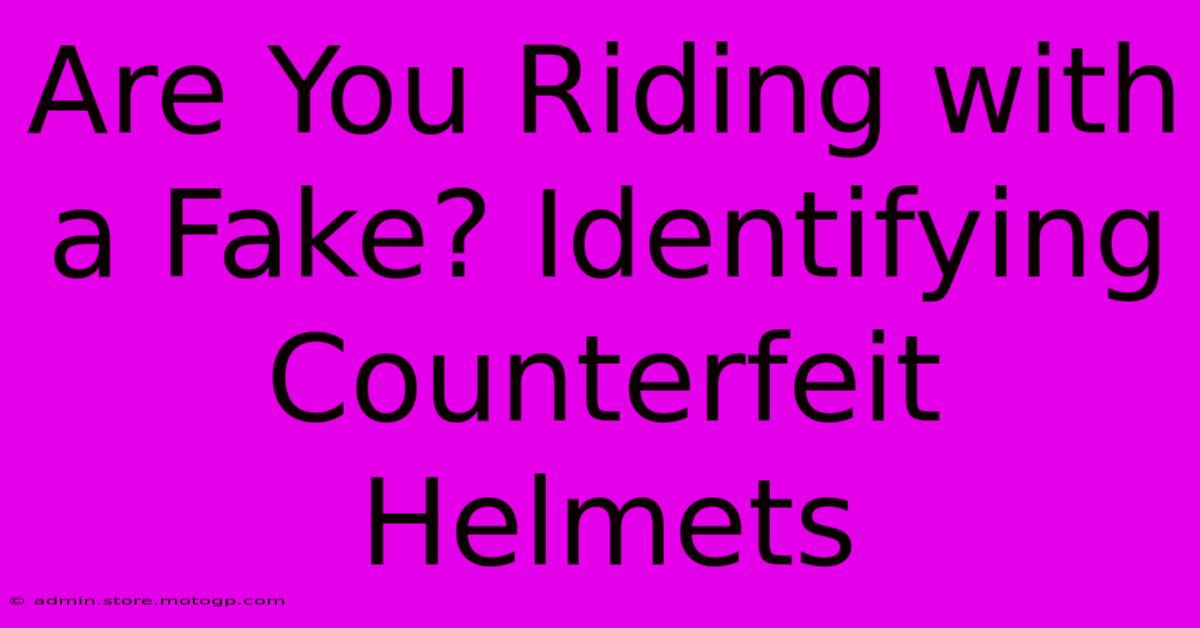Are You Riding With A Fake? Identifying Counterfeit Helmets

Table of Contents
Are You Riding with a Fake? Identifying Counterfeit Helmets
Motorcycle helmets are crucial for rider safety. A genuine helmet provides essential protection in a crash, but a counterfeit helmet? That's a different story altogether. Riding with a fake helmet puts your life at serious risk. This comprehensive guide will help you identify counterfeit motorcycle helmets and ensure you're always wearing genuine, reliable protection.
The Dangers of Counterfeit Helmets
Before diving into identification, let's understand the severity of the issue. Counterfeit helmets are often made with inferior materials and lack crucial safety features. This means they:
- Offer significantly reduced impact protection: In a crash, a fake helmet may shatter, crack, or deform inadequately, leaving you vulnerable to severe head injuries.
- Lack proper certification: Genuine helmets undergo rigorous testing and certification to meet safety standards (like DOT in the US or ECE in Europe). Counterfeits often skip these crucial steps.
- Have unreliable retention systems: The chin strap and other fastening mechanisms might fail during an accident, allowing the helmet to come off.
- Compromised visor quality: The visor might be made of substandard materials, offering poor visibility and inadequate protection from debris.
How to Spot a Fake Helmet
Identifying a counterfeit helmet requires careful inspection. Here's a breakdown of key areas to examine:
1. Packaging and Labeling:
- Check the packaging: Is it professional and consistent with the brand's typical packaging? Look for inconsistencies in printing, poor quality graphics, or spelling errors. Genuine helmets usually come in well-designed boxes with clear labeling.
- Scrutinize the labels: Examine the certification labels carefully (DOT, ECE, Snell, etc.). Counterfeits often have poorly reproduced or missing certifications. Look for inconsistencies in font, size, or placement compared to authentic helmets.
- Verify the manufacturer information: Check for the manufacturer's name, address, and contact details. Try to locate this information on the manufacturer's official website to verify its authenticity.
2. Helmet Construction and Materials:
- Assess the overall quality: Genuine helmets typically have a smooth, well-finished appearance. Look for rough edges, uneven paint jobs, or poorly fitted parts.
- Examine the shell: Check the shell for imperfections, inconsistencies in the paint or finish, or any signs of damage. Genuine helmets have a robust, high-quality shell.
- Inspect the padding and liner: The interior lining should be comfortable, well-stitched, and securely attached. Poor stitching or cheap-feeling materials are often indicators of a counterfeit.
- Check the retention system: The chin strap and buckle should be sturdy and securely fastened. A poorly designed or flimsy strap is a major red flag.
3. Price and Purchase Location:
- Be wary of extremely low prices: If a deal seems too good to be true, it probably is. Counterfeit helmets are often sold at significantly lower prices than genuine ones.
- Purchase from reputable sources: Buy your helmet from authorized dealers, reputable online retailers, or directly from the manufacturer. Avoid purchasing from unknown sellers or untrustworthy websites.
4. Using Online Resources:
- Check the manufacturer's website: Many helmet manufacturers provide guidance on identifying authentic products and list authorized retailers.
- Utilize online forums and communities: Connect with other riders and seek their advice on identifying counterfeit helmets.
- Contact the manufacturer directly: If you're unsure about a helmet's authenticity, contact the manufacturer for verification.
Protecting Yourself: The Bottom Line
Buying a counterfeit helmet is a gamble with your life. The savings are simply not worth the potential consequences. Always prioritize safety by purchasing your helmet from authorized sources and taking the time to thoroughly inspect it. Your head is worth it. Remember, a genuine helmet is an investment in your safety and peace of mind. Don't risk it with a fake.

Thank you for visiting our website wich cover about Are You Riding With A Fake? Identifying Counterfeit Helmets. We hope the information provided has been useful to you. Feel free to contact us if you have any questions or need further assistance. See you next time and dont miss to bookmark.
Featured Posts
-
Sprint Race Drama Moto Gps Most Intense Moments
Feb 18, 2025
-
High Definition Moto Gp Images For Your Desktop
Feb 18, 2025
-
The Perfect Gift For The Motorcycle Enthusiast A Moto Gp Helmet
Feb 18, 2025
-
Fuel Your Racing Dreams Bikes For Sale Now
Feb 18, 2025
-
The Sting Inside The World Of Formula 1
Feb 18, 2025
